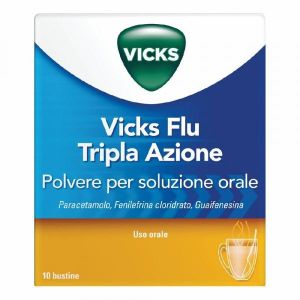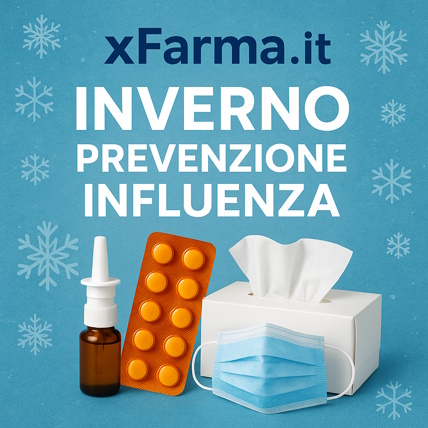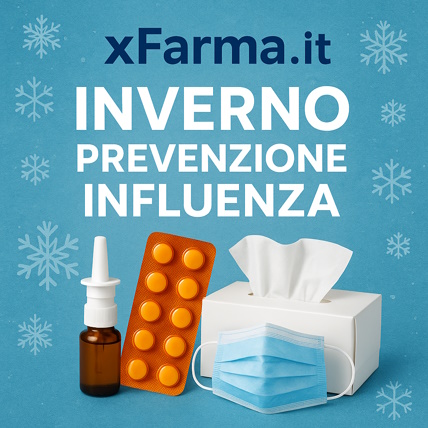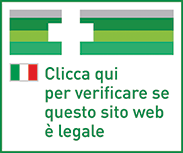Ship in Europe, Find out rates!
Vicks Flu Triple Action Powder Paracetamol Influenza 10 Envelopes

- box Delivery in Italy in 24/48 and free returns
- star3.000+ positive reviews
- dropboxOver 60,000 products in the catalog
Powder based on Paracetamol, phenylephrine HCl 10 mg and guaifenesin 200 mg.
Therapeutic indications
Vicks Flu Triple Action is used in the short-term symptomatic treatment of mild to moderate pain, fever, nasal congestion with an expectorant effect in case of a fat cough associated with colds, chills and flu.
Dosage and Posology
The drug should be taken according to the following doses and methods: dissolve the contents of a sachet in a medium-sized cup and add hot, not boiling water (about 250 ml). Allow to cool to a drinkable temperature.
In adults and children from 12 years of age: one sachet. Repeat every four hours according to the directions, without exceeding four doses (sachets) within 24 hours. Do not administer to children under 12 years of age without medical advice. Do not administer to patients with hepatic impairment or severe renal impairment. Consult a doctor if symptoms persist for more than 3 days.
Overdose
There is a risk of poisoning particularly in elderly patients, young children, in patients with liver disease, in chronic alcoholics, in patients with chronic malnutrition. In these cases, an overdose can be fatal. In adults, 10 g or more of paracetamol can cause liver damage. If the patient has any of the risk factors (see below), ingesting 5 g or more of paracetamol may cause liver damage.
Risk factors: if the patient:
- are on prolonged therapy with carbamazepine, phenobarbital, phenytoin, primidone, rifampicin, St. John's wort or other liver enzyme-inducing drugs, or
- regularly take ethanol in excess of recommended amounts or
- has a deficiency of glutathione, eg. in case of eating disorders, cystic fibrosis, HIV infection, starvation, cachexia.
Symptoms of paracetamol overdose that occur in the first 24 hours are paleness, nausea, vomiting, anorexia and abdominal pain. Liver damage can appear 12 to 48 hours after ingestion. Abnormalities of glucose metabolism and metabolic acidosis may occur. In cases of severe poisoning, liver failure can progress to encephalopathy, hemorrhage, hypoglycemia, brain edema, and death. Even in the absence of severe liver damage, acute renal failure with acute tubular necrosis can occur, highly likely if accompanied by low back pain, hematuria, and proteinuria. Cases of cardiac arrhythmia and pancreatitis have been reported.
In case of paracetamol overdose it is essential to treat the patient immediately. Even in the absence of significant initial symptoms, the patient must be urgently transferred to the hospital. Symptoms may be limited to nausea or vomiting and may not reflect the severity of the overdose or the risk of organ damage. Patient treatment must be carried out in compliance with current guidelines. If no more than one hour has elapsed since taking the overdose, treatment with activated charcoal may be considered. The plasma concentration of paracetamol should be measured no earlier than 4 hours after ingestion (plasma concentrations measured earlier are not reliable). The patient can be treated with N-acetylcysteine within 24 hours of ingesting paracetamol; however, the maximum protective effect is achieved within 8 hours of ingestion. After this time, the effectiveness of the antidote decreases dramatically. If necessary, the patient should be given intravenous N-acetylcysteine, in line with the established dosing schedule. In the event that vomiting is not a problem and the patient is away from the hospital, taking oral methionine may be a valid alternative. Treatment of patients with severe hepatic dysfunction presenting within 24 hours of ingestion should be discussed with the poison control center or a hepatology department.
Symptoms of phenylephrine overdose include irritability, headache, arterial hypertension, reflex bradycardia, and arrhythmias. Hypertension should be treated with an alpha blocker such as IV phentolamine. Reduction in blood pressure can reflexively increase heart rate but, if necessary, this can be facilitated by taking atropine.
A mild to moderate overdose of guaifenesin can cause dizziness and gastrointestinal upset. Very high doses can produce excitation, confusion and respiratory depression. Urinary stones have been reported in patients consuming large quantities of guaifenesin-containing preparations. Treatment is symptomatic and includes gastric lavage and general supportive measures.
Contraindications
- Hypersensitivity to the active substance or to any of the excipients
- Hepatic impairment or severe renal impairment
- Hypertension
- Hyperthyroidism
- Diabetes
- Heart disease
- Closed-angle glaucoma
- Porphyria
- Use in patients who are taking tricyclic antidepressants
- Use in patients who are taking, or have taken within the previous 2 weeks, monoamine oxidase inhibitors (MAOIs).
- Use in patients who are taking beta-blocker drugs
- Use in patients who are taking other sympathomimetic drugs
- Children under 12 years old.
Side effects
The incidence of undesirable effects is usually classified as follows: Very common (> 10) Common (> 1/100 to <1/10) Uncommon (> 1/1000 to <1/100) Rare (> 1 / 10,000 to <1/1000) Very rare (<1 / 10,000) Not known (the incidence cannot be classified from the available data)
- Cardiac disorders: Phenylephrine may rarely be associated with tachycardia (≥1 / 10,000 to ≤1 in 1000).
- Blood and lymphatic system disorders: Very rarely (<1 in 10,000) blood dyscrasias such as thrombocytopenia, agranulocytosis, haemolytic anemia, neutropenia, leukopenia and pancytopenia have been reported following the intake of paracetamol, although there may not be a causal relationship.
- Nervous system disorders: As with other sympathomimetic amines, insomnia, nervousness, tremor, anxiety, restlessness, confusion, irritability and headache may occur rarely (≥1 / 10,000 to ≤1 in 1000). It is also known that guaifenesin may rarely (≥1 / 10,000 to ≤1 in 1,000) cause headache and dizziness
- Gastrointestinal disorders: Anorexia, nausea and vomiting are common with sympathomimetics (≥1 in 100 to ≤1 in 10) and may occur with phenylephrine. Gastrointestinal upset, nausea, vomiting and diarrhea are the most common side effects associated with guaifenesin but occur rarely (≥1 / 10,000 to ≤1 in 1000). Gastrointestinal effects of paracetamol are very rare but cases of acute pancreatitis have been reported following ingestion of higher than normal doses.
- Renal and urinary disorders: Interstitial nephritis has been reported incidentally after prolonged use of high doses of paracetamol.
- Skin and subcutaneous tissue disorders: Hypersensitivity reactions, including skin rash, and urticaria (≥1 / 10,000 to ≤1 in 1000) may occur rarely. Very rare cases of severe skin reactions have been reported after taking paracetamol.
- Vascular disorders: Rarely, increased blood pressure associated with headache, vomiting and palpitations (≥1 / 10,000 to ≤1 in 1,000) may occur following the intake of phenylephrine.
- Immune system disorders: Rare cases (≥1 / 10,000 to ≤1 in 1,000) of allergic or hypersensitivity reactions have been reported following the intake of both phenylephrine and paracetamol, including skin rash, urticaria, anaphylaxis and bronchospasm .
- Hepatobiliary disorders: Rarely (≥ 1 / 10,000 to ≤ 1/1000), abnormal liver function tests (increased liver transaminases).
Pregnancy and breastfeeding
Epidemiological studies on pregnant women have shown the absence of negative effects due to the use of paracetamol in the recommended dosages; however, pregnant patients are required to follow their doctor's advice regarding the use of the drug. Paracetamol is excreted in breast milk, although not in clinically significant quantities. The published data available do not report contraindications regarding breastfeeding.
There are limited data on the use of phenylephrine in pregnancy. Vasoconstriction of uterine vessels and decreased uterine blood flow associated with the use of phenylephrine can cause fetal hypoxia. Until further information is available, the use of phenylephrine during pregnancy should be avoided, except in cases where the doctor deems it essential. There are no data available regarding the possible release of phenylephrine in breast milk nor are there any reports regarding the effects of phenylephrine on breastfed infants. Until further data are available, the intake of phenylephrine during breastfeeding should be avoided, except in cases where the physician deems it essential. The safety of guaifenesin in pregnancy and lactation has not yet been fully established. During pregnancy, the product should only be taken in cases where the doctor deems it essential.
Special warnings
Prolonged use of the product is not recommended. Patients should be advised not to take other products containing paracetamol or containing the same active ingredients as this preparation. Patients should also be advised to avoid concomitant intake of alcohol, other decongestant products, or products against coughs or colds. The doctor or pharmacist is required to verify that preparations containing sympathomimetics are not administered simultaneously through several routes, ie orally and topically (nasal, ear and eye preparations). This medicinal product should only be recommended in the presence of all symptoms (pain and / or fever, nasal congestion and bronchial cough). The risks associated with overdose are greater in patients with non-cirrhotic alcoholic liver disease. Use with caution in patients who are taking digitalis, beta-adrenergic blockers, methyldopa, or other antihypertensive agents.
Use with caution in patients with prostatic hypertrophy as they are potentially subject to urinary retention. Products containing sympathomimetics should be used with great care in patients who are taking phenothiazines. Use in patients with Raynaud's phenomenon. Consult your doctor before use in case of persistent or chronic cough such as that manifested by smoking, asthma, chronic bronchitis or emphysema. Contains sucrose. Patients with rare hereditary problems of fructose intolerance, glucose-galactose malabsorption or sucrase-isomaltase insufficiency should not take this medicine. Contains 157 mg of sodium per serving. To be taken into consideration in people with reduced kidney function or who follow a low sodium diet. Contains aspartame (E951). This medicine contains a source of phenylalanine. It can be harmful to you if you have phenylketonuria.
Expiration and retention
Check the expiration date indicated on the package. The expiry date indicated on the package refers to the product in intact packaging, correctly stored. Do not store above 25 ° C.
Warning : do not use the medicine after the expiry date indicated on the package.
Composition
One sachet of Vicks Flu Triple Action contains:
Active principle
500 mg of paracetamol 200 mg of guaifenesin 10 mg of phenylephrine hydrochloride
Excipients
Sucrose, Citric Acid, Tartaric Acid, Sodium Cyclamate, Sodium Citrate, Aspartame (E951), Acesulfame Potassium (E950), Menthol Powder, Lemon Flavor, Lemon Juice Flavor, Quinoline Yellow (E104)
| Destination | Cost | Detail |
|---|---|---|
| Italy | €5,90* | 24/72H |
| Austria, France, Germany, Slovenia | € 13* | 3 days |
| Belgium, Luxembourg, Portugal, Netherlands, Spain | € 14* | 4 days |
| Bulgary, Cechia, Hungary, Poland, Romania, Slovakia | € 19* | 5 days |
| Denmark, Estonia, Finland, Ireland, Lithuania, Latvia ,Sweden | € 22* | 5 days |
| United Kingdom, Switzerland, Greece, Malta/td> | € 30* | 7 days |
| Canada | € 40 | 7 Days |
European shipments with express courier: FedEx, MBE, DHL
*For the shipment outside band B ther's an extra cost of 22€ *For the shipment outside band C ther's an extra cost of 30€ Delivery Times exclude Saturday and Holidays
For Islands and Areas of difficult Accessibility the shipments are made in 72 hours and the cost will be increased by 15€


